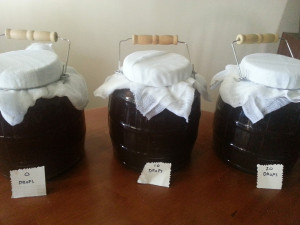Water Mineral Content and its Effects on Kombucha Fermentation
 So I learned that when beer companies go to start a new brewery and pick a location, a HUGE amount of money goes into the water that they use. Processing and filtering, usually trying to recreate some natural spring water that was used during the companies early years of brewing. This made me think that at least some attention should be paid to the same concept of kombucha tea brewing.
So I learned that when beer companies go to start a new brewery and pick a location, a HUGE amount of money goes into the water that they use. Processing and filtering, usually trying to recreate some natural spring water that was used during the companies early years of brewing. This made me think that at least some attention should be paid to the same concept of kombucha tea brewing.
I use reverse osmosis water for all my brews and as we all know, that water is devoid of anything. No minerals, no nothing. So I add trace mineral drops to the water I drink from it. The trace minerals includes a whole bunch of different minerals, to see the brand I use and a list of the mineral contents click here.
I was adding drops to water I drink but I was not sure about what effect it would have on a batch of KT. So a simple experiment was setup. I didn’t get pictures of the cultures this time but I will be sure to when I repeat the experiment the next time.
Setup:
3 separate gallon jars, all brewing the same tea with the same scoby source.
0 drops, 10 drops, and 20 drops were added to the three brews.
All other details were normal according to my how to brew kombucha tea page.
0 Drops
This would be the control in this experiment since all the brewing I had done prior to this has been purely reverse osmosis water with nothing added but the normal brewing recipe. This batch yielded a normal scoby and the taste of the KT was also average for what I expected.
Culture: normal
Tea: normal
10 Drops
Purely an observation experiment, I was not sure how things would go. This batch yielded a normal healthy scoby with a less smooth, irregular surface than the zero drops and the taste of the KT had a stronger vinegar flavor with more fizz.
Culture: healthy with a irregular surface
Tea: more vinegar taste and fizz compared to no drops
20 Drops
Based on the 10 drops I would have expected more fizz and maybe even higher taste of vinegar on the palette, but this turned out the opposite. The scoby was more irregular but not by much, the tea actually had a more rounded taste with less vinegar to it and a relaxed fizz.
Culture: healthy with a more irregular surface
Tea: less vinegar taste and milder fizz
Summary
This will have to be repeated since even when trying to control the conditions of an experiment, there are many things that change. The actual scoby health, temperature changes during the 2 weeks, and possibly other things unknown can contribute to the end results.
My conclusion is that there is probably an optimal amount of drops for each different factor you want to control. Some people prefer less fizzy drinks and might want to go higher on the amount of minerals, while others will search for the most possible fizz. My wife and I were sort of torn between the effects of the 10 and 20 drops so the next batch we are growing now has 15 drops in every jar. I will include anything interesting about that batch in about 2 weeks when its done.